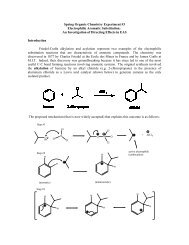Fall Organic Chemistry Experiment #6 Fractional Crystallization ...
Fall Organic Chemistry Experiment #6 Fractional Crystallization ...
Fall Organic Chemistry Experiment #6 Fractional Crystallization ...
You also want an ePaper? Increase the reach of your titles
YUMPU automatically turns print PDFs into web optimized ePapers that Google loves.
Enantiomers are nonsuperimposable mirror image structures. If you recall from Chapter 4 of<br />
your text, when a molecule contains a central carbon with four different colored groups (white,<br />
red, blue, and green), we say that the carbon is a stereogenic atom. We can configure the four<br />
groups around the stereogenic carbon to produce two different arrangements of atoms. The<br />
resultant pair of structures are mirror images of one another that are non-superimposable. In fact,<br />
if you try to superimpose the two molecules you will only get any two of the four colored groups<br />
to coincide. This enantiomeric pair represents one example of a molecular system that is chiral<br />
(exhibits handedness). See Chapter 4 for further discussion about chirality and stereochemistry.<br />
If you notice in Figure 2, each compound can be labeled either R or S. These notations<br />
are commonly used to identify the absolute configuration at each chiral center in your molecule.<br />
The absolute configuration is used designate the precise relationship in three-dimensional space<br />
for each group attached to the asymmetric carbon. Each of the groups is assigned a priority based<br />
upon its atomic number. For example, in the enantiomeric pair shown above, the chlorine<br />
(Cl=17) is the highest priority group, followed by the hydoxyl group (O=8), methyl group (C=6),<br />
and hydrogen (H=1), respectively. In assigning the R or S designation, a model is made and the<br />
lowest priority group (in this case, the hydrogen) is placed 180° away from the observer. The<br />
other three groups in order of highest to lowest priority are assigned. The relative relationship is<br />
then determined: they are arranged either clockwise (R) or counterclockwise (S). This<br />
assignment is shown in Figure 3.<br />
Figure 3<br />
Now, remember that we said, "the study of stereoisomers and their effects on chemical<br />
reactivity is called stereochemistry". The second part of this statement is very important. There<br />
are many examples in organic chemistry where stereochemistry plays an integral part in the<br />
course of a chemical reaction. You will later learn that in the course of a chemical reaction a<br />
bridged intermediate may form. One such example is shown below. This bridge effectively<br />
blocks one face of the molecule resulting in the attack of the nucleophile (Br-) from the open face<br />
as shown in Figure 4. For more on this type of reaction, you can refer to pages 442-449 from<br />
your text.

















